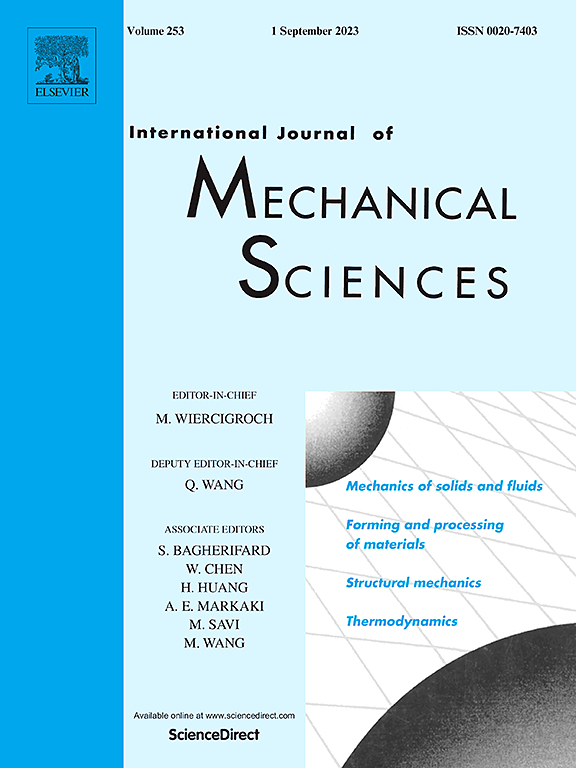Weakened adhesion on elastic film via patterned adhesion
IF 7.1
1区 工程技术
Q1 ENGINEERING, MECHANICAL
International Journal of Mechanical Sciences
Pub Date : 2025-01-24
DOI:10.1016/j.ijmecsci.2025.109992
引用次数: 0
Abstract
High strength of adhesion is vital for various creatures and engineering applications. However, strong adhesion between printed parts and the release film turns out to be an insurmountable obstacle in digital light processing (DLP) 3D printing technology, and adhesion weakening is highly desired to speed up the fabrication efficiency. In this work, a strategy of sector pattern is proposed to reduce the adhesion force of a rigid punch detaching from a pre-stretched film. A theoretical model is proposed and solved by Fourier–Bessel series method to analyze the decohesion mechanism. Complemented by finite element simulations, we see that the reduction ratio of pull-off force can be attributed to the shortened ratio of periphery length. The sector pattern of the adhesive area ratio has the reduction ratio of for JKR limit (film of low stiffness, strong interfacial adhesion) and for DMT limit (film of large stiffness, low interfacial adhesion). The theoretical and numerical results are validated experimentally by decohesion between printed cylinder parts and a fluorinated ethylene propylene (FEP) film. Our study may deepen the understanding of the decohesion mechanism of patterned adhesion and provide a design criterion for reduced pull-off force in DLP 3D printing and similar engineering applications.

求助全文
约1分钟内获得全文
求助全文
来源期刊

International Journal of Mechanical Sciences
工程技术-工程:机械
CiteScore
12.80
自引率
17.80%
发文量
769
审稿时长
19 days
期刊介绍:
The International Journal of Mechanical Sciences (IJMS) serves as a global platform for the publication and dissemination of original research that contributes to a deeper scientific understanding of the fundamental disciplines within mechanical, civil, and material engineering.
The primary focus of IJMS is to showcase innovative and ground-breaking work that utilizes analytical and computational modeling techniques, such as Finite Element Method (FEM), Boundary Element Method (BEM), and mesh-free methods, among others. These modeling methods are applied to diverse fields including rigid-body mechanics (e.g., dynamics, vibration, stability), structural mechanics, metal forming, advanced materials (e.g., metals, composites, cellular, smart) behavior and applications, impact mechanics, strain localization, and other nonlinear effects (e.g., large deflections, plasticity, fracture).
Additionally, IJMS covers the realms of fluid mechanics (both external and internal flows), tribology, thermodynamics, and materials processing. These subjects collectively form the core of the journal's content.
In summary, IJMS provides a prestigious platform for researchers to present their original contributions, shedding light on analytical and computational modeling methods in various areas of mechanical engineering, as well as exploring the behavior and application of advanced materials, fluid mechanics, thermodynamics, and materials processing.
 求助内容:
求助内容: 应助结果提醒方式:
应助结果提醒方式:


